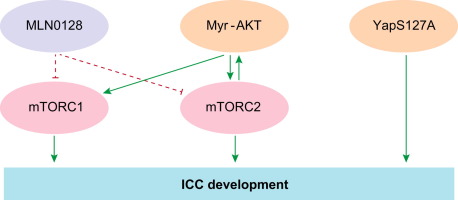当前位置:
X-MOL 学术
›
J. Hepatol.
›
论文详情
Our official English website, www.x-mol.net, welcomes your feedback! (Note: you will need to create a separate account there.)
Pan-mTOR inhibitor MLN0128 is effective against intrahepatic cholangiocarcinoma induced in mice by AKT and Yap co-expression
Journal of Hepatology ( IF 25.7 ) Pub Date : 2017-12-01 , DOI: 10.1016/j.jhep.2017.07.006 Shanshan Zhang , Xinhua Song , Dan Cao , Zhong Xu , Biao Fan , Li Che , Junjie Hu , Bin Chen , Mingjie Dong , Maria G. Pilo , Antonio Cigliano , Katja Evert , Silvia Ribback , Frank Dombrowski , Rosa M. Pascale , Antonio Cossu , Gianpaolo Vidili , Alberto Porcu , Maria M. Simile , Giovanni M. Pes , Gianluigi Giannelli , John Gordan , Lixin Wei , Matthias Evert , Wenming Cong , Diego F. Calvisi , Xin Chen
Journal of Hepatology ( IF 25.7 ) Pub Date : 2017-12-01 , DOI: 10.1016/j.jhep.2017.07.006 Shanshan Zhang , Xinhua Song , Dan Cao , Zhong Xu , Biao Fan , Li Che , Junjie Hu , Bin Chen , Mingjie Dong , Maria G. Pilo , Antonio Cigliano , Katja Evert , Silvia Ribback , Frank Dombrowski , Rosa M. Pascale , Antonio Cossu , Gianpaolo Vidili , Alberto Porcu , Maria M. Simile , Giovanni M. Pes , Gianluigi Giannelli , John Gordan , Lixin Wei , Matthias Evert , Wenming Cong , Diego F. Calvisi , Xin Chen

|
BACKGROUND & AIMS
Intrahepatic cholangiocarcinoma (ICC) is a lethal malignancy without effective treatment options. MLN0128, a second generation pan-mTOR inhibitor, shows efficacy for multiple tumor types. We evaluated the therapeutic potential of MLN0128 vs. gemcitabine/oxaliplatin in a novel ICC mouse model. METHODS
We established a novel ICC mouse model via hydrodynamic transfection of activated forms of AKT (myr-AKT) and Yap (YapS127A) protooncogenes (that will be referred to as AKT/YapS127A). Genetic approaches were applied to study the requirement of mTORC1 and mTORC2 in mediating AKT/YapS127A driven tumorigenesis. Gemcitabine/oxaliplatin and MLN0128 were administered in AKT/YapS127A tumor-bearing mice to study their anti-tumor efficacy in vivo. Multiple human ICC cell lines were used for in vitro experiments. Hematoxylin and eosin staining, immunohistochemistry and immunoblotting were applied for the characterization and mechanistic study. RESULTS
Co-expression of myr-AKT and YapS127A promoted ICC development in mice. Both mTORC1 and mTORC2 complexes were required for AKT/YapS127A ICC development. Gemcitabine/oxaliplatin had limited efficacy in treating late stage AKT/YapS127A ICC. In contrast, partial tumor regression was achieved when MLN0128 was applied in the late stage of AKT/YapS127A cholangiocarcinogenesis. Furthermore, when MLN0128 was administered in the early stage of AKT/YapS127A carcinogenesis, it led to disease stabilization. Mechanistically, MLN0128 efficiently inhibited AKT/mTOR signaling both in vivo and in vitro, inducing strong ICC cell apoptosis and only marginally affecting proliferation. CONCLUSIONS
This study suggests that mTOR kinase inhibitors may be beneficial for the treatment of ICC, even in tumors that are resistant to standard of care chemotherapeutics, such as gemcitabine/oxaliplatin-based regimens, especially in the subset of tumors exhibiting activated AKT/mTOR cascade. Lay summary: We established a novel mouse model of intrahepatic cholangiocarcinoma (ICC). Using this new preclinical model, we evaluated the therapeutic potential of mTOR inhibitor MLN0128 vs. gemcitabine/oxaliplatin (the standard chemotherapy for ICC treatment). Our study shows the anti-neoplastic potential of MLN0128, suggesting that it may be superior to gemcitabine/oxaliplatin-based chemotherapy for the treatment of ICC, especially in the tumors exhibiting activated AKT/mTOR cascade.
中文翻译:

Pan-mTOR抑制剂MLN0128对AKT和Yap共表达诱导的小鼠肝内胆管癌有效
背景和目的 肝内胆管癌 (ICC) 是一种致命的恶性肿瘤,没有有效的治疗选择。MLN0128 是第二代泛 mTOR 抑制剂,显示出对多种肿瘤类型的疗效。我们在新型 ICC 小鼠模型中评估了 MLN0128 与吉西他滨/奥沙利铂的治疗潜力。方法我们通过水动力转染活化形式的 AKT (myr-AKT) 和 Yap (YapS127A) 原癌基因(将称为 AKT/YapS127A)建立了一种新型 ICC 小鼠模型。应用遗传方法来研究 mTORC1 和 mTORC2 在介导 AKT/YapS127A 驱动的肿瘤发生中的需求。吉西他滨/奥沙利铂和 MLN0128 在 AKT/YapS127A 荷瘤小鼠体内给药以研究它们的体内抗肿瘤功效。多种人ICC细胞系用于体外实验。苏木精和伊红染色、免疫组织化学和免疫印迹被应用于表征和机制研究。结果 myr-AKT 和 YapS127A 的共表达促进了小鼠的 ICC 发育。AKT/YapS127A ICC 开发需要 mTORC1 和 mTORC2 复合物。吉西他滨/奥沙利铂治疗晚期 AKT/YapS127A ICC 的疗效有限。相比之下,在 AKT/YapS127A 胆管癌发生晚期应用 MLN0128 时,实现了部分肿瘤消退。此外,当在 AKT/YapS127A 癌变的早期阶段施用 MLN0128 时,它导致疾病稳定。从机制上讲,MLN0128 在体内和体外均能有效抑制 AKT/mTOR 信号传导,诱导强烈的 ICC 细胞凋亡,并且仅略微影响增殖。结论 本研究表明,mTOR 激酶抑制剂可能有益于 ICC 的治疗,即使在对标准护理化疗药物(如基于吉西他滨/奥沙利铂的方案)耐药的肿瘤中,尤其是在表现出激活 AKT/mTOR 级联反应的肿瘤亚组中. 总结:我们建立了一种新型的肝内胆管癌(ICC)小鼠模型。使用这种新的临床前模型,我们评估了 mTOR 抑制剂 MLN0128 与吉西他滨/奥沙利铂(ICC 治疗的标准化疗)的治疗潜力。我们的研究显示了 MLN0128 的抗肿瘤潜力,表明它在治疗 ICC 方面可能优于基于吉西他滨/奥沙利铂的化疗,尤其是在表现出激活 AKT/mTOR 级联反应的肿瘤中。即使在对标准护理化疗药物(例如基于吉西他滨/奥沙利铂的方案)耐药的肿瘤中,尤其是在表现出激活的 AKT/mTOR 级联的肿瘤亚组中。总结:我们建立了一种新型的肝内胆管癌(ICC)小鼠模型。使用这种新的临床前模型,我们评估了 mTOR 抑制剂 MLN0128 与吉西他滨/奥沙利铂(ICC 治疗的标准化疗)的治疗潜力。我们的研究显示了 MLN0128 的抗肿瘤潜力,表明它在治疗 ICC 方面可能优于基于吉西他滨/奥沙利铂的化疗,尤其是在表现出激活 AKT/mTOR 级联反应的肿瘤中。即使在对标准护理化疗药物(例如基于吉西他滨/奥沙利铂的方案)耐药的肿瘤中,尤其是在表现出激活的 AKT/mTOR 级联的肿瘤亚组中。总结:我们建立了一种新型的肝内胆管癌(ICC)小鼠模型。使用这种新的临床前模型,我们评估了 mTOR 抑制剂 MLN0128 与吉西他滨/奥沙利铂(ICC 治疗的标准化疗)的治疗潜力。我们的研究显示了 MLN0128 的抗肿瘤潜力,表明它在治疗 ICC 方面可能优于基于吉西他滨/奥沙利铂的化疗,尤其是在表现出激活 AKT/mTOR 级联反应的肿瘤中。尤其是在表现出激活的 AKT/mTOR 级联的肿瘤亚群中。总结:我们建立了一种新型的肝内胆管癌(ICC)小鼠模型。使用这种新的临床前模型,我们评估了 mTOR 抑制剂 MLN0128 与吉西他滨/奥沙利铂(ICC 治疗的标准化疗)的治疗潜力。我们的研究显示了 MLN0128 的抗肿瘤潜力,表明它在治疗 ICC 方面可能优于基于吉西他滨/奥沙利铂的化疗,尤其是在表现出激活 AKT/mTOR 级联反应的肿瘤中。尤其是在表现出激活的 AKT/mTOR 级联的肿瘤亚群中。总结:我们建立了一种新型的肝内胆管癌(ICC)小鼠模型。使用这种新的临床前模型,我们评估了 mTOR 抑制剂 MLN0128 与吉西他滨/奥沙利铂(ICC 治疗的标准化疗)的治疗潜力。我们的研究显示了 MLN0128 的抗肿瘤潜力,表明它在治疗 ICC 方面可能优于基于吉西他滨/奥沙利铂的化疗,尤其是在表现出激活 AKT/mTOR 级联反应的肿瘤中。
更新日期:2017-12-01
中文翻译:

Pan-mTOR抑制剂MLN0128对AKT和Yap共表达诱导的小鼠肝内胆管癌有效
背景和目的 肝内胆管癌 (ICC) 是一种致命的恶性肿瘤,没有有效的治疗选择。MLN0128 是第二代泛 mTOR 抑制剂,显示出对多种肿瘤类型的疗效。我们在新型 ICC 小鼠模型中评估了 MLN0128 与吉西他滨/奥沙利铂的治疗潜力。方法我们通过水动力转染活化形式的 AKT (myr-AKT) 和 Yap (YapS127A) 原癌基因(将称为 AKT/YapS127A)建立了一种新型 ICC 小鼠模型。应用遗传方法来研究 mTORC1 和 mTORC2 在介导 AKT/YapS127A 驱动的肿瘤发生中的需求。吉西他滨/奥沙利铂和 MLN0128 在 AKT/YapS127A 荷瘤小鼠体内给药以研究它们的体内抗肿瘤功效。多种人ICC细胞系用于体外实验。苏木精和伊红染色、免疫组织化学和免疫印迹被应用于表征和机制研究。结果 myr-AKT 和 YapS127A 的共表达促进了小鼠的 ICC 发育。AKT/YapS127A ICC 开发需要 mTORC1 和 mTORC2 复合物。吉西他滨/奥沙利铂治疗晚期 AKT/YapS127A ICC 的疗效有限。相比之下,在 AKT/YapS127A 胆管癌发生晚期应用 MLN0128 时,实现了部分肿瘤消退。此外,当在 AKT/YapS127A 癌变的早期阶段施用 MLN0128 时,它导致疾病稳定。从机制上讲,MLN0128 在体内和体外均能有效抑制 AKT/mTOR 信号传导,诱导强烈的 ICC 细胞凋亡,并且仅略微影响增殖。结论 本研究表明,mTOR 激酶抑制剂可能有益于 ICC 的治疗,即使在对标准护理化疗药物(如基于吉西他滨/奥沙利铂的方案)耐药的肿瘤中,尤其是在表现出激活 AKT/mTOR 级联反应的肿瘤亚组中. 总结:我们建立了一种新型的肝内胆管癌(ICC)小鼠模型。使用这种新的临床前模型,我们评估了 mTOR 抑制剂 MLN0128 与吉西他滨/奥沙利铂(ICC 治疗的标准化疗)的治疗潜力。我们的研究显示了 MLN0128 的抗肿瘤潜力,表明它在治疗 ICC 方面可能优于基于吉西他滨/奥沙利铂的化疗,尤其是在表现出激活 AKT/mTOR 级联反应的肿瘤中。即使在对标准护理化疗药物(例如基于吉西他滨/奥沙利铂的方案)耐药的肿瘤中,尤其是在表现出激活的 AKT/mTOR 级联的肿瘤亚组中。总结:我们建立了一种新型的肝内胆管癌(ICC)小鼠模型。使用这种新的临床前模型,我们评估了 mTOR 抑制剂 MLN0128 与吉西他滨/奥沙利铂(ICC 治疗的标准化疗)的治疗潜力。我们的研究显示了 MLN0128 的抗肿瘤潜力,表明它在治疗 ICC 方面可能优于基于吉西他滨/奥沙利铂的化疗,尤其是在表现出激活 AKT/mTOR 级联反应的肿瘤中。即使在对标准护理化疗药物(例如基于吉西他滨/奥沙利铂的方案)耐药的肿瘤中,尤其是在表现出激活的 AKT/mTOR 级联的肿瘤亚组中。总结:我们建立了一种新型的肝内胆管癌(ICC)小鼠模型。使用这种新的临床前模型,我们评估了 mTOR 抑制剂 MLN0128 与吉西他滨/奥沙利铂(ICC 治疗的标准化疗)的治疗潜力。我们的研究显示了 MLN0128 的抗肿瘤潜力,表明它在治疗 ICC 方面可能优于基于吉西他滨/奥沙利铂的化疗,尤其是在表现出激活 AKT/mTOR 级联反应的肿瘤中。尤其是在表现出激活的 AKT/mTOR 级联的肿瘤亚群中。总结:我们建立了一种新型的肝内胆管癌(ICC)小鼠模型。使用这种新的临床前模型,我们评估了 mTOR 抑制剂 MLN0128 与吉西他滨/奥沙利铂(ICC 治疗的标准化疗)的治疗潜力。我们的研究显示了 MLN0128 的抗肿瘤潜力,表明它在治疗 ICC 方面可能优于基于吉西他滨/奥沙利铂的化疗,尤其是在表现出激活 AKT/mTOR 级联反应的肿瘤中。尤其是在表现出激活的 AKT/mTOR 级联的肿瘤亚群中。总结:我们建立了一种新型的肝内胆管癌(ICC)小鼠模型。使用这种新的临床前模型,我们评估了 mTOR 抑制剂 MLN0128 与吉西他滨/奥沙利铂(ICC 治疗的标准化疗)的治疗潜力。我们的研究显示了 MLN0128 的抗肿瘤潜力,表明它在治疗 ICC 方面可能优于基于吉西他滨/奥沙利铂的化疗,尤其是在表现出激活 AKT/mTOR 级联反应的肿瘤中。


























 京公网安备 11010802027423号
京公网安备 11010802027423号